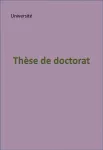| Titre : |
DART: An efficient 3D Monte Carlo vector radiative transfer model for remote sensing applications |
| Titre original : |
Modélisation 3D du transfert radiatif avec polarisation pour l'étude des surfaces terrestres par télédétection |
| Type de document : |
Thèse/HDR |
| Auteurs : |
Yingjie Wang, Auteur ; Jean-Philippe Gastellu-Etchegorry, Directeur de thèse ; A. Deschamps, Directeur de thèse |
| Editeur : |
Toulouse : Université de Toulouse |
| Année de publication : |
2022 |
| Importance : |
248 p. |
| Format : |
21 x 30 cm |
| Note générale : |
Bibliographie
Thèse en vue de l'obtention du Doctorat de l'Université de Toulouse, spécialité Surfaces et interfaces continentales, hydrologie |
| Langues : |
Anglais (eng) |
| Descripteur : |
[Vedettes matières IGN] Traitement d'image optique
[Termes IGN] distribution du coefficient de réflexion bidirectionnelle BRDF
[Termes IGN] méthode de Monte-Carlo
[Termes IGN] modèle de transfert radiatif
[Termes IGN] modélisation 3D
[Termes IGN] polarisation
[Termes IGN] radiance
|
| Index. décimale : |
THESE Thèses et HDR |
| Résumé : |
(auteur) Accurate understanding of the land surface functioning, such as the energy budget, carbon and water cycles, and ecosystem dynamics, is essential to better interpret, predict and mitigate the impact of the expected global changes. It thus requires observing our planet at different spatial and temporal scales that only the remote sensing (RS) can achieve because of its ability to provides systematic and synoptic radiometric observations. These observations can be transformed to surface parameters (e.g., temperature, vegetation biomass, etc.) used as input in process models (e.g., evapotranspiration) or be assimilated in the latter. Understanding the radiation interactions in the land surface and atmosphere is essential in two aspects: interpret RS signals as information about the observed land surfaces, and model the processes of functioning of land surfaces where the radiation participates. This explains the development of radiative transfer models (RTMs) that simulate the radiative budget and RS observations. The initial 3D RTMs in the 1980s simulated basic radiation mechanisms in very schematic representations of land surfaces (e.g., turbid medium, geometric primitive). Since then, their accuracy and performance have been greatly improved to address the increasing need of accurate information about land surfaces as well as the advances of RS instruments. So far, two types of improvements are still needed: 1. More accurate and efficient radiative transfer (RT) modelling (e.g., polarization, specular reflection, atmospheric scattering and emission, etc.) 2. Representation of land surfaces at different realism degrees and spatial scales. DART is one of the most accurate and comprehensive 3D RTMs (dart.omp.eu). It simulates the radiative budget and RS observations of urban and natural landscapes, with topography and atmosphere, from the ultraviolet to the thermal infrared domains. Its initial version, DART-FT, in 1992, used the discrete ordinates method to iteratively track the radiation along finite number of discrete directions in voxelized representations of the landscapes. It has been validated with other RTMs, and also RS and field measurements. However, it cannot simulate RS observations with the presently needed precision because of its voxelized representation of landscapes, and absence of some physical mechanisms (e.g., polarization). During this thesis, in collaboration with the DART team, I developed in DART a new Monte Carlo vector RT mode called DART-Lux that takes full advantage of the latest advances in RT modelling, especially in computer graphics. The central idea is to transfer the radiation transfer problem as a multi-dimensional integral problem and solve it with the Monte Carlo method that is considerably efficient and accurate in computing multi-dimensional integral such as the complex mechanisms (e.g., polarization) in realistic representations of 3D landscapes. For that, I implemented the bidirectional path tracing algorithm that generates a group of "source-sensor" paths by connecting two sub-paths, one is generated starting from the light source and another one is generated starting from the sensor. Then, the contribution of these paths to the integral is estimated by the multiple importance sampling. This method allows to accurately and efficiently simulate polarimetric RS observations of kilometre-scale realistic landscapes coupled with plane-parallel atmosphere, with consideration of the anisotropic scattering, the thermal emission, and the solar induced fluorescence. Compared to DART-FT, DART-Lux improves the computer efficiency (i.e., computer time and memory) usually by a factor of more than 100 for large-scale and complex landscapes. It provides new perspectives for studying the land surface functioning and also for preparing Earth observation satellite missions such as the missions TRISHNA (CNES and ISRO), LSTM and next generation Sentinel-2 (ESA), and CHANGE (NASA). |
| Note de contenu : |
General introduction
1- Radiometry and radiative transfer
2- Numerical models for radiative transfer
3- DART-Lux: theory and implementation
4- Modelling of atmospheric effects
5- Modelling of polarization
Conclusion and perspectives |
| Numéro de notice : |
24106 |
| Affiliation des auteurs : |
non IGN |
| Thématique : |
IMAGERIE |
| Nature : |
Thèse française |
| Organisme de stage : |
CESBIO |
| DOI : |
sans |
| En ligne : |
https://www.theses.fr/2022TOU30173 |
| Format de la ressource électronique : |
URL |
| Permalink : |
https://documentation.ensg.eu/index.php?lvl=notice_display&id=103060 |
|  |

